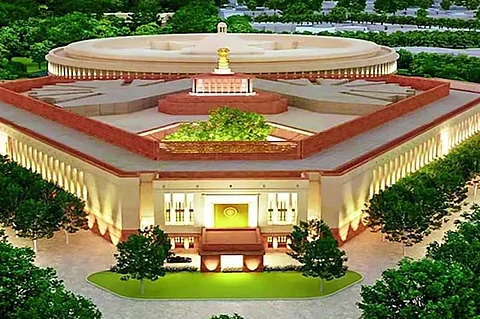

The Indian Council of Medical Research (ICMR) – National Institute for Research in Environmental Health has conducted a systematic review of studies on the presence of microplastics in the human body, Kirti Vardhan Singh, Minister of State in the Ministry of Environment, Forest and Climate Change, told the Rajya Sabha.
According to the findings, there is currently a lack of dose-response and toxicity exposure studies on microplastics. Separately, a committee comprising the Central Pollution Control Board (CPCB), ICMR, the Central Institute of Petrochemicals Engineering & Technology and the National Centre for Sustainable Coastal Management, coordinated by the CPCB, submitted a report to the National Green Tribunal.
The report acknowledged studies confirming the presence of microplastics in the human body but notes the absence of research on their physiological or psychological impacts, the minister stated.
The India State of Forest Report (ISFR) 2023 has recorded West Bengal’s forest cover as 16,832.33 square kilometres, compared to 16,902 square kilometres in ISFR 2019, Singh told the Rajya Sabha.
Out of West Bengal’s 23 districts, 13 have shown an increase in forest cover, while 10 have experienced a decline compared to ISFR 2021, ISFR 2023 stated. The districts reporting a decrease in forest cover include Cooch Behar, Dakshin Dinajpur, Darjeeling, Hooghly, Howrah, Murshidabad, North 24 Parganas, Purba Medinipur, South 24 Parganas and Uttar Dinajpur.
According to data from the Forest Survey of India, Dehradun, a total of 2,03,544 forest fire incidents were detected between November 2023 and June 2024 using the Suomi National Polar-orbiting Partnership Visible Infrared Imaging Radiometer Suite sensor, Singh told the Rajya Sabha.
In 2020, India’s total greenhouse gas (GHG) emissions were 2,958.6 million tonnes of carbon dioxide equivalent, excluding Land Use, Land-Use Change and Forestry (LULUCF), Singh told the Rajya Sabha.
When LULUCF is included, the emissions stood at 2,436.7 million tonnes. This data was reported in India’s fourth Biennial Update Report submitted to the United Nations Framework Convention on Climate Change on December 30, 2024, the minister stated.
Nitrous oxide (N2O) accounts for 5.1 per cent of India’s total GHG emissions. India is the fourth-largest emitter of N2O, after China, the United States and Brazilm, he added.
According to data provided by State Pollution Control Boards and Pollution Control Committees to CPCB, the total plastic waste generated in India in 2022-23 was 4.13 million tonnes, Singh informed the Rajya Sabha.
The Department of Atomic Energy, in collaboration with IDRS Labs Pvt Ltd, Bengaluru, has launched a food supplement/nutraceutical named AKTOCYTE, aimed at improving the quality of life for cancer patients undergoing radiotherapy, Jitendra Singh, Union Minister of State for Personnel, Public Grievances and Pensions and Minister of State in the Prime Minister’s Office, informed the Rajya Sabha.
Scientists from the Bhabha Atomic Research Centre, Mumbai; the Advanced Centre for Training, Research and Education in Cancer, Navi Mumbai; Tata Memorial Hospital, Mumbai; and IDRS Labs contributed to its development. This product is expected to play a significant role in making cancer care more affordable in India, the minister said.
Significant progress has been made in expanding access to tap water for rural households under the Jal Jeevan Mission, C R Paatil, Union Minister of Jal Shakti, told the Lok Sabha. At the time of the programme’s launch in August 2019, 32.3 million (16.71 per cent) rural households had tap water connections.
As of March 18, 2025, approximately 122.9 million additional rural households have been provided with tap water under the scheme, bringing the total number of households with tap water access to 155.3 million (80.20 per cent) out of 193.6 million rural households, the minister added.
As of now, eight states — Goa, Telangana, Gujarat, Haryana, Punjab, Himachal Pradesh, Arunachal Pradesh and Mizoram — and three Union Territories — Puducherry, Dadra & Nagar Haveli and Daman & Diu and the Andaman & Nicobar Islands — have achieved ‘Har Ghar Jal’ status, meaning 100 per cent of households have access to tap water, Paatil said.
The Government of India launched the Namami Gange Programme (NGP) in 2014-15 for the rejuvenation of the Ganga and its tributaries, including the Yamuna river, Raj Bhushan Choudhary, Minister of State for Jal Shakti, told the Lok Sabha.
Initially sanctioned for five years until March 2021, the programme has been extended until March 2026. Under the NGP, 33 projects have been approved to create a sewage treatment capacity of 2,130 million litres per day at a cost of Rs 5,911 crore for the Yamuna, Choudhary said.
The Central Ground Water Board (CGWB) has released the Annual Groundwater Quality Report 2024, based on groundwater sampling and analysis from 15,259 monitoring locations nationwide, Choudhary told the Lok Sabha.
The report detected contaminants exceeding prescribed limits for human consumption in isolated pockets of certain states and union territories. However, it concludes that overall, groundwater in India remains largely suitable for drinking and agricultural use, the minister stated.
The Union Ministry of Housing and Urban Affairs does not maintain data of electric buses (e-buses) in the specific format requested, Tokhan Sahu, Union Minister of State for the ministry, told the Lok Sabha. However, the ministry launched the “PM eBus Sewa Scheme” on August 16, 2023, a centrally sponsored initiative aimed at expanding city bus operations in urban areas.
The scheme provides Rs 20,000 crore in central assistance for deploying 10,000 electric buses under the public-private partnership (PPP) model. So far, the ministry has sanctioned 7,293 e-buses for 14 states and four union territories, Sahu said.